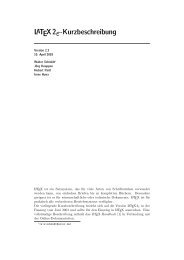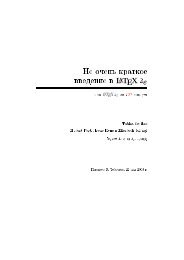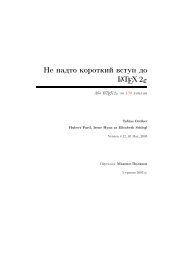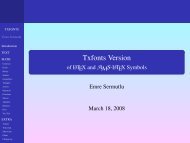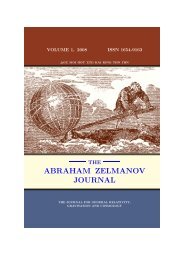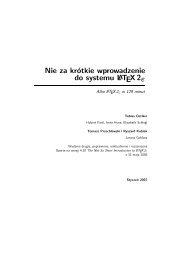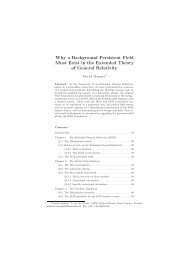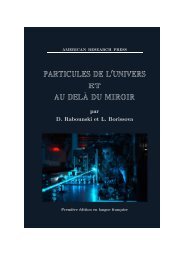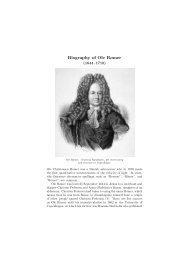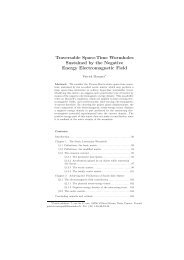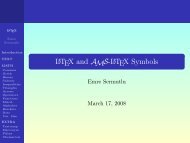The Comprehensive LaTeX Symbol List
The Comprehensive LaTeX Symbol List
The Comprehensive LaTeX Symbol List
Create successful ePaper yourself
Turn your PDF publications into a flip-book with our unique Google optimized e-Paper software.
<strong>The</strong> following are some additional notes about the contents of Table 288:• A “(tc)” after a symbol name means that the textcomp package must be loaded to access that symbol.A “(T1)” means that the symbol requires the T1 font encoding. <strong>The</strong> fontenc package can change thefont encoding document-wide.• Many of the \text. . . accents can also be produced using the accent commands shown in Table 18 onpage 13 plus an empty argument. For instance, \={} is essentially the same as \textasciimacron.• <strong>The</strong> commands in the “L A TEX 2ε” columns work both in body text and within a \texttt{. . .} command(or, more generally, when \ttfamily is in effect).• <strong>The</strong> “£” and “$” glyphs occupy the same slot (36) of the OT1 font encoding, with “£” appearing in italicfonts and “$” appearing in roman fonts. A problem with L A TEX’s default handling of this double-mappingis that “{\sffamily\slshape\pounds}” produces “$”, not “£”. Other font encodings use separate slotsfor the two characters and are therefore robust to the problem of “£”/”$” conflicts. Authors who use\pounds should select a font encoding other than OT1 (as explained on page 7) or use the textcomppackage, which redefines \pounds to use the TS1 font encoding.• Character 173, \-, is shown as “-” but is actually a discretionary hyphen; it appears only at the end ofa line.Microsoft ® Windows ® normally uses a superset of Latin 1 called “Code Page 1252” or “CP1252” forshort. CP1252 introduces symbols in the Latin 1 “invalid” range (characters 128–159). Table 289 presents thecharacters with which CP1252 augments the standard Latin 1 table.Table 289: L A TEX 2ε Code Page 1252 TableDec Hex Char L A TEX 2ε128 80 € \texteuro (tc)130 82 ‚ \quotesinglbase (T1)131 83 f \textit{f}132 84 „ \quotedblbase (T1)133 85 . . . \dots134 86 † \dag135 87 ‡ \ddag136 88 ˆ \textasciicircum137 89 ‰ \textperthousand (tc)138 8A Š \v{S}139 8B ‹ \guilsinglleft (T1)140 8C Œ \OE142 8E Ž \v{Z}Dec Hex Char L A TEX 2ε145 91 ‘ ‘146 92 ’ ’147 93 “ ‘‘148 94 ” ’’149 95 • \textbullet150 96 – --151 97 — ---152 98 ˜ \textasciitilde153 99 \texttrademark154 9A š \v{s}155 9B › \guilsinglright (T1)156 9C œ \oe158 9E ž \v{z}159 9F Ÿ \"{Y}<strong>The</strong> following are some additional notes about the contents of Table 289:• As in Table 288, a “(tc)” after a symbol name means that the textcomp package must be loaded to accessthat symbol. A “(T1)” means that the symbol requires the T1 font encoding. <strong>The</strong> fontenc package canchange the font encoding document-wide.• Not all characters in the 128–159 range are defined.• Look up “euro signs” in the index for alternatives to \texteuro.While too large to incorporate into this document, a listing of ISO 8879:1986 SGML/XML character entitiesand their L A TEX equivalents is available from http://www.bitjungle.com/~isoent/. Some of the characterspresented there make use of isoent, a L A TEX 2ε package (available from the same URL) that fakes some of themissing ISO glyphs using the L A TEX picture environment. 1313 isoent is not featured in this document, because it is not available from CTAN and because the faked symbols are not “true”characters; they exist in only one size, regardless of the body text’s font size.103



